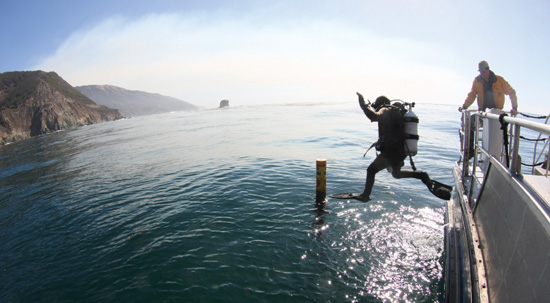Teams of scientists are conducting the most comprehensive assessment ever undertaken of California's coastal ecosystems as part of a monitoring program for the growing network of marine protected areas along the coast.
Ongoing monitoring will enable scientists to track the effects of the new marine reserves and change their management if some reserves appear to be less effective than others. The surveys will also help researchers document the effects of climate change on the state's coastal ecosystems.
The first reserves created under California's Marine Life Protection Act (MLPA) were established in 2007 along the central California coast, from Pigeon Point in San Mateo County south to Point Conception. The 29 marine protected areas (MPAs) in this region include "no-take" reserves where no fishing or harvesting is allowed, as well as areas with different levels of limited use.
Mark Carr, professor of ecology and evolutionary biology at the University of California, Santa Cruz, led the baseline monitoring surveys of kelp forests in this region. "These are the most extensive ecological surveys to date of kelp forests along the central coast, so we now have a much better picture of what those ecosystems are like and how they vary geographically," Carr said.
Other teams surveyed a range of additional habitats in the region, from the tidepools and algae-covered rocks in the intertidal zone to deep-water reefs. Peter Raimondi, professor and chair of ecology and evolutionary biology at UC Santa Cruz, led the surveys of the rocky intertidal zone. Scientists with California Sea Grant and the National Marine Fisheries Service led surveys using submersibles to assess deep-water habitats, worked with recreational fishers to collect data on nearshore fish species, and conducted socioeconomic surveys to enable tracking of the economic impacts of the central coast MPAs.
MPAs for the north central coast (from Pigeon Point north to Alder Creek, near Point Arena) were approved last year and are expected to take effect April 1. In February, the Ocean Protection Council awarded $4 million to support baseline monitoring of the north central coast region, about half of which is for projects managed by Raimondi and Carr.
The north central coast monitoring program, which is being overseen by a new MPA Monitoring Enterprise, will be even more comprehensive than the central coast monitoring, covering a wider range of habitats. "The MPA monitoring program has made a real effort to bring together groups that can do rigorous assessments across all the coastal systems; it's assessing all the nearshore habitats in a very integrated way, and that just hasn't been done before," Raimondi said.
For the kelp forest surveys, scuba divers collect data on the size and abundance of all conspicuous fish species; measure the kelp forest canopy; count sea urchins, abalone and other invertebrates; and record a range of other ecologically important features both inside and outside of the protected areas. "It's a heck of a lot of work," Carr said.
Of the 29 MPAs designated on the central coast, 17 contain kelp forests, of which 14 could be safely surveyed by scuba divers. Analyses of baseline data showed that the sites surveyed outside the protected areas were similar to those inside in terms of the habitat features and the assemblages of fish, invertebrates, and algae. "That's good news, because now we can continue to track this through time and see if there are divergences between the protected and unprotected sites," Carr said.
The results of kelp forest baseline monitoring surveys have just been published in a booklet that is available, along with other summaries of baseline data, from the Partnership for Interdisciplinary Studies of Coastal Oceans (PISCO) (downloads are available here).
PISCO, a collaborative program funded by the David and Lucile Packard Foundation and the Gordon and Betty Moore Foundation, has been monitoring coastal ecosystems along the west coast of North America since 1999. Raimondi and Carr are both PISCO investigators. Federal agencies have also funded surveys of coastal resources. The MPA monitoring program is building on these earlier efforts to assess coastal ecosystems, Raimondi said.
"Long before MPAs came along, the importance of monitoring coastal resources was recognized by agencies and foundations, so we've been doing these kinds of assessments for a long time," he said. "But the MPA monitoring is more intensive and more directed; the goal is to assess the performance of this network of MPAs."
The effects on coastal ecosystems of protection within an MPA will become apparent over the next five to 10 years, with some systems showing faster responses than others, Carr said. "We may start to see some changes in the kelp forests by the fifth year," he said. "An increase in the sizes of individual fish is one of the earlier responses we would expect to see, because fishing targets the bigger fish, and after that would be changes in the numbers of fish."
Changes are also expected to spread beyond the borders of the MPAs, Carr said. "By increasing the spawning stock of populations within the MPAs, they will be producing larvae that can replenish populations all along the coastline," he said.
Raimondi said he expects to see a rapid response in the abalone population on the north central coast, because recreational abalone fishing is so popular there. "It appears to be pretty well managed, but in the shallow areas there has been a lot of abalone extraction, so we're expecting a quick response in the protected areas," he said.
Raimondi's team is preparing a publication on the results of surveys of the rocky intertidal zone all along the west coast since 1992. He said it should be available within the next year.
MPAs proposed for the south coast region (from Point Conception south to the Mexican border) may be adopted by the end of the year. The planning process for north coast MPAs (from Alder Creek to the Oregon border) is currently under way, and San Francisco Bay will be the fifth and final region to go through the MLPA planning process.



